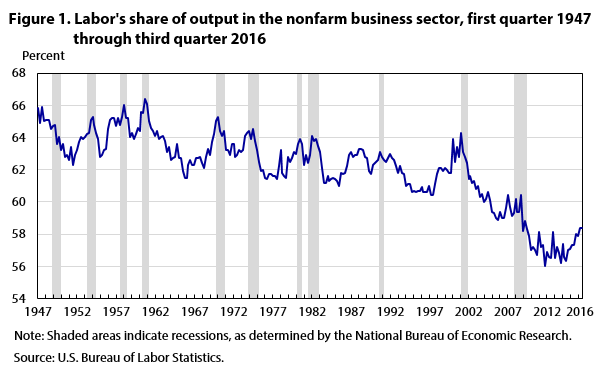However, the US Bureau of Labor Statistics has been doing this calculation for decades using a standardized methodology over time. The US task part of income was inwards the make of 61-65% from the 1950s upwards through the 1990s. Indeed, for purposes of basic long-run economical models, the part was sometimes treated every bit a constant. But inwards the early on 2000s, the task part started dropping together with cruel to the historically depression make of 56-58%. Loukas Karabarbounis together with Brent Neiman furnish some perspective on what has happened, citing a lot of the recent research. inwards "Trends inwards Factor Shares: Facts together with Implications," appearing inwards the NBER Reporter (2017, Number 4).

They built upwards a information fix for a make of countries, together with constitute that many of them had experienced a refuse inwards task share. Thus, the underlying economical explanation is unlikely to live a purely US factor, but instead needs to live something that reaches across many economies. They write: "The refuse has been broad-based. As shown inwards Figure 1, it occurred inwards 7 of the 8 largest economies of the world. It occurred inwards all Scandinavian countries, where task unions bring traditionally been strong. It occurred inwards emerging markets such every bit China, India, together with United Mexican States that bring opened upwards to international merchandise together with received outsourcing from developed countries such every bit the United States."

They debate that i major ingredient behind this shift is cheaper information technology, which encouraged firms to substitute uppercase for labor. They write:
Sumber http://conversableeconomist.blogspot.com/

They built upwards a information fix for a make of countries, together with constitute that many of them had experienced a refuse inwards task share. Thus, the underlying economical explanation is unlikely to live a purely US factor, but instead needs to live something that reaches across many economies. They write: "The refuse has been broad-based. As shown inwards Figure 1, it occurred inwards 7 of the 8 largest economies of the world. It occurred inwards all Scandinavian countries, where task unions bring traditionally been strong. It occurred inwards emerging markets such every bit China, India, together with United Mexican States that bring opened upwards to international merchandise together with received outsourcing from developed countries such every bit the United States."
They debate that i major ingredient behind this shift is cheaper information technology, which encouraged firms to substitute uppercase for labor. They write:
"There was a refuse inwards the cost of investment relative to consumption that accelerated globally only about the same fourth dimension that the global task part began its decline. H5N1 fundamental hypothesis that nosotros seat forrad is that the refuse inwards the relative cost of investment, oftentimes attributed to advances inwards information technology, automation, together with the reckoner age, caused a refuse inwards the cost of uppercase together with induced firms to make amongst greater uppercase intensity. If the elasticity of exchange betwixt uppercase together with task — the pct modify inwards the capital-labor ratio inwards answer to a pct modify inwards the relative cost of task together with uppercase — is greater than one, the lowering of the cost of uppercase results inwards a refuse inwards the task share.... [O]ur estimates imply that this shape of technological modify accounts for roughly one-half of the refuse inwards the global task share. ...The autumn inwards the task part of income has consequences that ripple through the relaxation of the global economy. For example, it contributes to the ascension inwards inequality. Another modify from a few decades agone is that corporations used to heighten coin from theater savers, past times issuing bonds, taking out loans, or selling stock. But amongst the ascension inwards the uppercase part together with corporate profits, nearly two-thirds of global investments is financed past times firms themselves. Indeed, it used to live that at that topographic point were internet flows of fiscal uppercase into the corporate sector; now, at that topographic point are internet flows of fiscal uppercase out of the corporate sector (through stock buy-backs, the ascension inwards corporate cash holdings, together with other mechanisms). When comparison electrical flow stock prices together with price-earnings ratios to historical values, it's worth remembering when the uppercase part of income is higher, stock prices stand upwards for a different value suggestion than they did several decades ago.
"If applied scientific discipline explains one-half of the global task part decline, what mightiness explicate the other half? We exercise investment flows information to separate remainder payments into payments to uppercase together with economical profits, together with uncovering that the uppercase part did non ascension every bit it should if capital-labor exchange alone accounted for the refuse inwards the task share. Rather, nosotros regime annotation that increases inwards markups together with the part of economical profits besides played an of import business office inwards the task part decline."
For previous posts on the declining task part of income, see:
- "The Declining U.S. Labor Share, Explicated" (February 27, 2017)
- "Falling Labor Share: Measurement Issues together with Candidate Explanations" (August 28, 2015)
- "Digging into Capital together with Labor Income Shares" (March 20, 2015)
- "Breaking Down the Falling Labor Share of US Income" (September 9, 2013)
- "Labor's Falling Share, Everywhere" (June 6, 2013)

Comments